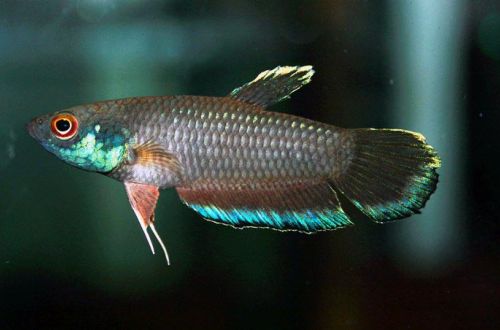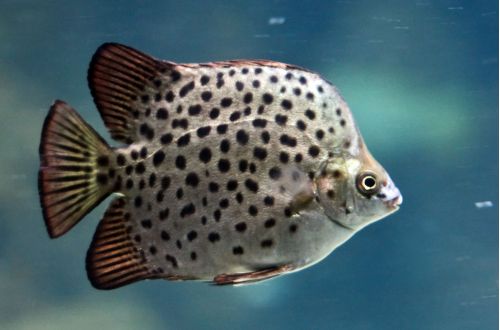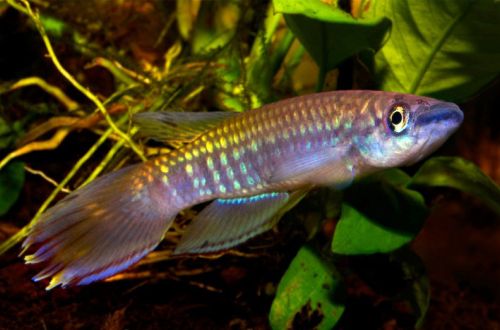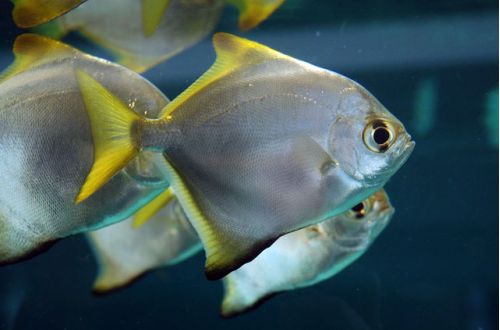
Cockerel-Borneo
Betta striped or Cockerel-Borneo, scientific name Betta taeniata, belongs to the Osphronemidae family. According to the classification, it belongs to the group of fighting fish, however, this affiliation did not affect their behavior in any way. It is considered a peaceful calm fish, able to get along well with relatives and other species of comparable size. It is unpretentious and will not cause big problems with its content.

Contents
Habitat
Comes from Southeast Asia. It is endemic to the island of Borneo. Found worldwide, wild individuals have been caught in various locations, particularly in the southern state of Sarawak, Malaysia and the northern province of Kalimantan Barat, Indonesia. Inhabits streams and rivers with clean clear water, sometimes slightly turbid, running in fast streams from hills covered with tropical forest. Fish prefer relatively calm regions, backwaters, where they stay closer to the shore among aquatic and overhanging vegetation. The substrates consist of stones and sand mixed with fallen leaves, twigs through which massive tree roots pass.
Brief information:
- The volume of the aquarium – from 50 liters.
- Temperature – 22-27°C
- Value pH — 5.0–7.0
- Water hardness – 0–10 dGH
- Substrate type – any dark
- Lighting – subdued
- Brackish water – no
- Water movement – little or no
- The size of the fish is about 5 cm.
- Food – any food
- Temperament – peaceful
- Content – alone, in pairs or in a group
Description
Adults reach about 5 cm. Males, unlike females, grow larger, the color is darker, in some cases a wide light strip runs along the middle of the body, and bright turquoise colors appear on the lower part of the head, edges of the fins and tail. Females are paler in color, the main color is gray.
Food
Most of the Betta fish on the market have successfully adapted to accepting the “bag” food that is popular in the aquarium hobby. Many manufacturers produce special products for fighting fish, which may well become the main diet. A good addition to the diet will be live or frozen brine shrimp, daphnia, bloodworms, etc.
Maintenance and care, arrangement of the aquarium
An aquarium of 50 liters will be quite sufficient for one pair of fish. When keeping, it is important to ensure a stable aquatic environment in an acceptable range of temperatures and values of hydrochemical parameters. To achieve this goal, the necessary equipment is installed and mandatory aquarium maintenance procedures are carried out, including at least two actions: weekly replacement of part of the water with fresh water and regular removal of organic waste (food leftovers, excrement).
The set of equipment depends on many factors, ranging from the volume of water, the number of fish and ending with the aesthetic appearance, brand, financial capabilities of the aquarist, etc. Despite this, one thing must be for sure – the filtration system, even if it consists of a simple airlift filter with a sponge.
Like any other Labyrinth fish, the Borneo Cockerel breathes not only dissolved oxygen in the water, but also swallows air bubbles from the surface. To minimize the risks of damage to its additional respiratory organ, it is necessary to keep a layer of warm moist air above the water. This is easy to achieve by installing a tight cover on the aquarium.
The choice of design doesn’t really matter. Many breeders and pet stores often have fish in half-empty tanks. Such a habitat, of course, is not optimal, but acceptable. The aquarium is still worth decorating by adding aquatic plants, driftwood, soil and other decorative elements to it.
Behavior and Compatibility
Belonging to the group of fighting fish does not make them cocky inhabitants of the aquarium, on the contrary, Betta striped is distinguished by a peaceful, calm disposition both in relation to relatives and to other fish. However, there is competition between males for the attention of females, but it does not come to fierce fights with each other. In large aquariums, rivalry is completely reduced to nothing.
Breeding / breeding
This species belongs to a group of fish that do not form clutch and do not spawn on the ground or among plant thickets. The fertilized eggs are hatched in the mouth of one of the parents, in this case the male. A similar breeding strategy is also characteristic of other families, for example, Malawian cichlids.
With the onset of the mating season, the alpha male chooses a female and proceeds to courtship. The spawning process itself resembles a “dance of hugs”, the fish are closely pressed against each other, wrapping their bodies around. At this moment, fertilization occurs and the male takes the eggs into his mouth, where they will stay for 9-12 days. The fry are born fully formed and ready to eat. It is recommended to feed with specialized food for fry, or Artemia nauplii. It is noted that fry grow faster in the presence of parents, who, however, do not pay any attention to them, but at the same time do not try to eat them.
Fish diseases
The cause of most diseases is unsuitable conditions of detention. A stable habitat will be the key to successful keeping. In the event of symptoms of the disease, first of all, the quality of the water should be checked and, if deviations are found, measures should be taken to correct the situation. If symptoms persist or even worsen, medical treatment will be required. Read more about symptoms and treatments in the Aquarium Fish Diseases section.





